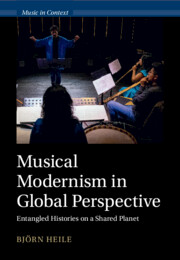Book contents
- Musical Modernism in Global Perspective
- Music in Context
- Musical Modernism in Global Perspective
- Copyright page
- Contents
- Tables
- Examples
- Supplementary Material
- Acknowledgements
- Note on the Text
- Introduction
- Part I Rethinking the Historiography of Musical Modernism
- 1 Echoes of The Rite in Latin-American Music and Literature
- 2 Exile, Migration and Mobility
- 3 Institutionalised Internationalism
- Part II Two Case Studies
- Bibliography
- Index
1 - Echoes of The Rite in Latin-American Music and Literature
from Part I - Rethinking the Historiography of Musical Modernism
Published online by Cambridge University Press: 23 May 2024
- Musical Modernism in Global Perspective
- Music in Context
- Musical Modernism in Global Perspective
- Copyright page
- Contents
- Tables
- Examples
- Supplementary Material
- Acknowledgements
- Note on the Text
- Introduction
- Part I Rethinking the Historiography of Musical Modernism
- 1 Echoes of The Rite in Latin-American Music and Literature
- 2 Exile, Migration and Mobility
- 3 Institutionalised Internationalism
- Part II Two Case Studies
- Bibliography
- Index
Summary
The Latin-American premiere of Igor Stravinsky’s The Rite of Spring in 1928 in Buenos Aires caused a sensation, and in subsequent years the work was regularly performed across much of the continent. The work also found many imitators, but Latin-American composers understood the work differently from their peers elsewhere. Whereas in Europe and North America, The Rite’s avowed primitivism appeared mostly as a lurid but non-specific signifier of otherness, composers such as Alberto Ginastera and Heitor Villa-Lobos drew direct parallels between Stravinsky’s paganism and indigenismo, the evocation of the continent’s pre-Columbian past and indigenous heritage. In a move characteristic of settler colonialism, what they found in Stravinsky’s work was not a European import but an Asiatic, pre-Christian legacy that could act as a foundation for an indigenous form of musical modernism beyond Eurocentric models. By contrast, the Cuban writer Alejo Carpentier associated Stravinsky’s Scythians with the descendants of the Yoruba, the largest group of enslaved Africans in Cuba. In this way, the chapter analyses transnational networks and entanglements between Russia, Europe and several Latin-American countries.
Keywords
- Type
- Chapter
- Information
- Musical Modernism in Global PerspectiveEntangled Histories on a Shared Planet, pp. 31 - 65Publisher: Cambridge University PressPrint publication year: 2024



